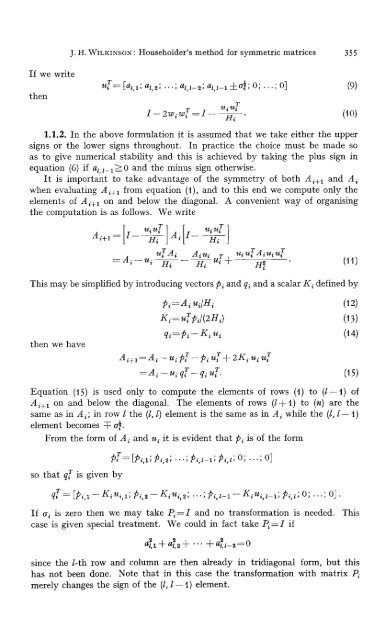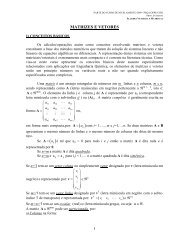Householder's method for symmetric matrices
Householder's method for symmetric matrices
Householder's method for symmetric matrices
You also want an ePaper? Increase the reach of your titles
YUMPU automatically turns print PDFs into web optimized ePapers that Google loves.
If we write<br />
then<br />
J. H. ~u : <strong>Householder's</strong> <strong>method</strong> ~or <strong>symmetric</strong> <strong>matrices</strong> 3 5 5<br />
u~= [al,1; al,~; ...; al,,-2; ai, l-1 0;...; O] (9)<br />
I- 2w, w~ = I ~' ~ (to)<br />
Hi<br />
1.1.2. In the above <strong>for</strong>mulation it is assumed that we take either the upper<br />
signs or the lower signs throughout. In practice the choice must be made so<br />
as to give numerical stability and this is achieved by taking the plus sign in<br />
equation (6) if at, l_l>=O and the minus sign otherwise.<br />
It is important to take advantage of the symmetry of both Ai+ ~ and A~<br />
when evaluating Ai+ 1 from equation (1), and to this end we compute only the<br />
elements of Ai+ 1 on and below the diagonal. A convenient way of organising<br />
the computation is as follows. We write<br />
~ A~ u~+ (11)<br />
----- A ~ -- u i H~ H~ H~<br />
This may be simplified by introducing vectors p~ and qi and a scalar K i defined by<br />
then we have<br />
p~ =A~ udH~ (t2)<br />
Ki=u~pd(2H3 (t3)<br />
qi=P~-- Ki u~ (t4)<br />
Equation (t5) is used only to compute the elements of rows (/) to (l--t) of<br />
A~+~ on and below the diagonal. The elements of rows (l+t) to (n) are the<br />
same as in A i; in row l the (1, l) element is the same as in A i while the (l, l -- t)<br />
element becomes T a~.<br />
From the <strong>for</strong>m of A~ and u i it is evident that Pi is of the <strong>for</strong>m<br />
so that q~ is given by<br />
PT=- EP~,~; P~,~; ..." P~,~-~; P~,~; 0; ...; o~<br />
q~-~ [Pi, x --Kiui,1; Pi,2 --Kiui,2; ... ; Pi, l-x- Kiui, l-1; P~,z; 0; ... ; 0~.<br />
If a~ is zero then we may take P~=I and no trans<strong>for</strong>mation is needed. This<br />
case is given special treatment. We could in fact take P~= I if<br />
a~,x + at,~ + ... +a~,~_~=0<br />
since the l-th row and column are then already in tridiagonal <strong>for</strong>m, but this<br />
has not been done. Note that in this case the trans<strong>for</strong>mation with matrix P~<br />
merely changes the sign of the (l, l -- ~) element.






